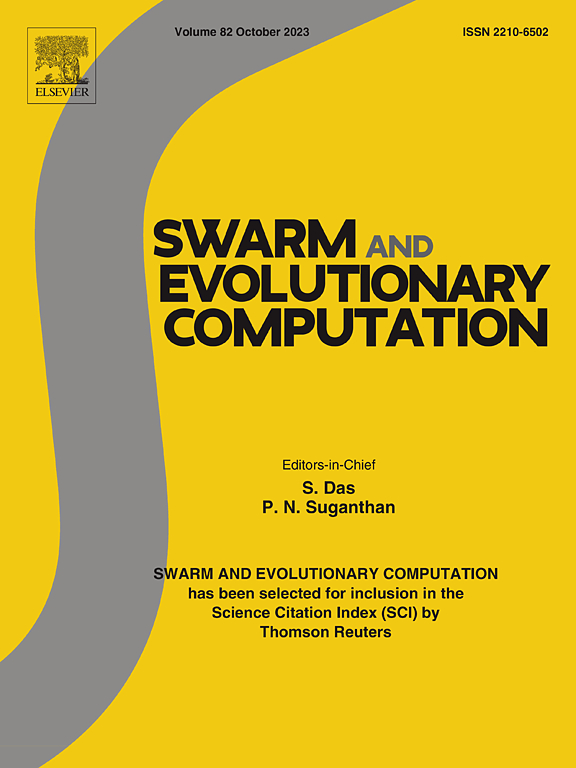Convolutional neural network combined with reinforcement learning-based dual-mode grey wolf optimizer to identify crop diseases and pests
IF 8.2
1区 计算机科学
Q1 COMPUTER SCIENCE, ARTIFICIAL INTELLIGENCE
引用次数: 0
Abstract
Agriculture is crucial for national food security, but crop pests and diseases pose significant threats. Traditional manual methods for detection are subjective, costly, and less accurate. Deep learning, especially convolutional neural network, is revolutionizing crop pest and disease identification, manual hyperparameter tuning can lead to suboptimal results. In contrast, grey wolf optimizer has demonstrated effective global search capabilities in hyperparameter optimization, improving model performance. Therefore, a reinforcement learning-based dual-mode grey wolf optimizer is introduced to enhance the performance of the original algorithm in hyperparameter optimization and identify the optimal hyperparameters, which combines a dynamic elite learning strategy and a dual-mode adaptive strategy well balanced with the exploration and exploitation of populations, while the integration of the reinforcement learning technique strengthens the information feedback. To validate the effectiveness of the proposed algorithm, additional ablation experiments were conducted, and experiments using CPU time as the termination criterion were included to increase rigor and ensure fairness. The main hyperparameters of convolutional neural network optimized by the proposed algorithm is utilized for the recognition of the pentatomidae stinkbug pests and corn diseases, with experimental results compared against six other intelligent optimization algorithms. Results from two sets of experiments indicate that the proposed algorithm improves the recognition accuracy of the original convolutional neural networks model, achieving the highest accuracy on the pest dataset at 95.83 % and on the corn disease dataset at 96.51 %.
卷积神经网络结合基于强化学习的双模灰狼优化器识别作物病虫害
农业对国家粮食安全至关重要,但作物病虫害构成重大威胁。传统的人工检测方法是主观的,昂贵的,而且不太准确。深度学习,特别是卷积神经网络,正在彻底改变作物病虫害识别,人工超参数调整可能导致次优结果。相比之下,灰狼优化器在超参数优化中表现出了有效的全局搜索能力,提高了模型的性能。为此,引入基于强化学习的双模灰狼优化器,提高原算法在超参数优化方面的性能,识别出最优的超参数,将动态精英学习策略和双模自适应策略与种群的探索和利用相结合,强化学习技术的集成增强了信息反馈。为了验证所提算法的有效性,我们进行了额外的消融实验,并加入了以CPU时间作为终止标准的实验,以增加严谨性和保证公平性。将该算法优化的卷积神经网络的主要超参数用于五角星科臭虫病虫害和玉米病害的识别,并将实验结果与其他六种智能优化算法进行了比较。两组实验结果表明,该算法提高了原始卷积神经网络模型的识别精度,在害虫数据集和玉米病害数据集上分别达到95.83%和96.51%的最高准确率。
本文章由计算机程序翻译,如有差异,请以英文原文为准。
求助全文
约1分钟内获得全文
求助全文
来源期刊

Swarm and Evolutionary Computation
COMPUTER SCIENCE, ARTIFICIAL INTELLIGENCEC-COMPUTER SCIENCE, THEORY & METHODS
CiteScore
16.00
自引率
12.00%
发文量
169
期刊介绍:
Swarm and Evolutionary Computation is a pioneering peer-reviewed journal focused on the latest research and advancements in nature-inspired intelligent computation using swarm and evolutionary algorithms. It covers theoretical, experimental, and practical aspects of these paradigms and their hybrids, promoting interdisciplinary research. The journal prioritizes the publication of high-quality, original articles that push the boundaries of evolutionary computation and swarm intelligence. Additionally, it welcomes survey papers on current topics and novel applications. Topics of interest include but are not limited to: Genetic Algorithms, and Genetic Programming, Evolution Strategies, and Evolutionary Programming, Differential Evolution, Artificial Immune Systems, Particle Swarms, Ant Colony, Bacterial Foraging, Artificial Bees, Fireflies Algorithm, Harmony Search, Artificial Life, Digital Organisms, Estimation of Distribution Algorithms, Stochastic Diffusion Search, Quantum Computing, Nano Computing, Membrane Computing, Human-centric Computing, Hybridization of Algorithms, Memetic Computing, Autonomic Computing, Self-organizing systems, Combinatorial, Discrete, Binary, Constrained, Multi-objective, Multi-modal, Dynamic, and Large-scale Optimization.
 求助内容:
求助内容: 应助结果提醒方式:
应助结果提醒方式:


